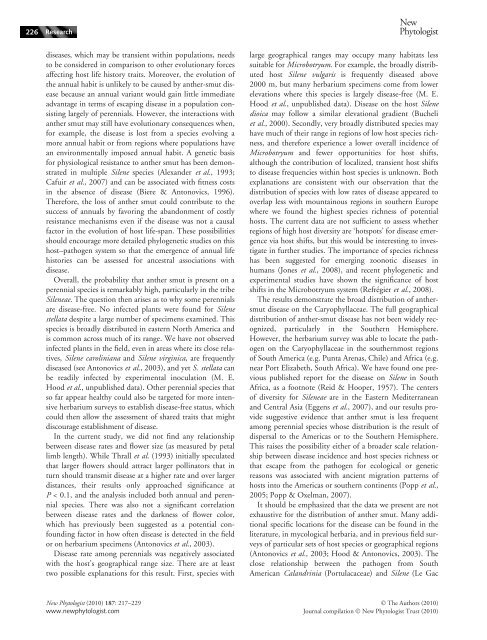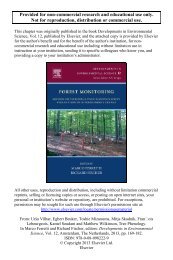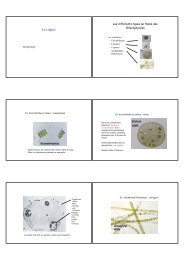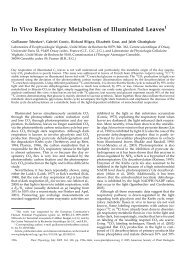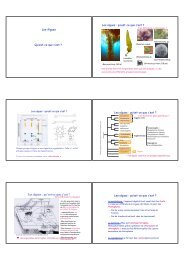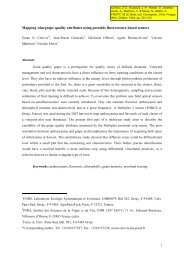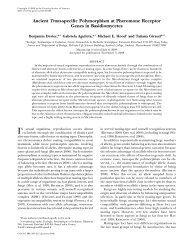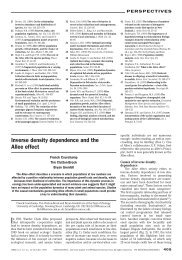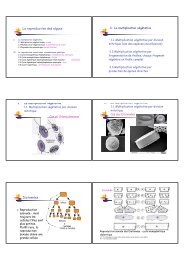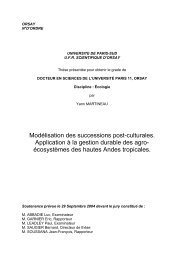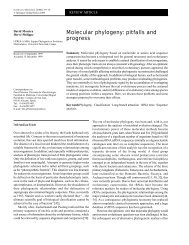Distribution of the anthersmut pathogen Microbotryum on species of ...
Distribution of the anthersmut pathogen Microbotryum on species of ...
Distribution of the anthersmut pathogen Microbotryum on species of ...
You also want an ePaper? Increase the reach of your titles
YUMPU automatically turns print PDFs into web optimized ePapers that Google loves.
226 ResearchNewPhytologistdiseases, which may be transient within populati<strong>on</strong>s, needsto be c<strong>on</strong>sidered in comparis<strong>on</strong> to o<str<strong>on</strong>g>the</str<strong>on</strong>g>r evoluti<strong>on</strong>ary forcesaffecting host life history traits. Moreover, <str<strong>on</strong>g>the</str<strong>on</strong>g> evoluti<strong>on</strong> <str<strong>on</strong>g>of</str<strong>on</strong>g><str<strong>on</strong>g>the</str<strong>on</strong>g> annual habit is unlikely to be caused by an<str<strong>on</strong>g>the</str<strong>on</strong>g>r-smut diseasebecause an annual variant would gain little immediateadvantage in terms <str<strong>on</strong>g>of</str<strong>on</strong>g> escaping disease in a populati<strong>on</strong> c<strong>on</strong>sistinglargely <str<strong>on</strong>g>of</str<strong>on</strong>g> perennials. However, <str<strong>on</strong>g>the</str<strong>on</strong>g> interacti<strong>on</strong>s withan<str<strong>on</strong>g>the</str<strong>on</strong>g>r smut may still have evoluti<strong>on</strong>ary c<strong>on</strong>sequences when,for example, <str<strong>on</strong>g>the</str<strong>on</strong>g> disease is lost from a <strong>species</strong> evolving amore annual habit or from regi<strong>on</strong>s where populati<strong>on</strong>s havean envir<strong>on</strong>mentally imposed annual habit. A genetic basisfor physiological resistance to an<str<strong>on</strong>g>the</str<strong>on</strong>g>r smut has been dem<strong>on</strong>stratedin multiple Silene <strong>species</strong> (Alexander et al., 1993;Cafuir et al., 2007) and can be associated with fitness costsin <str<strong>on</strong>g>the</str<strong>on</strong>g> absence <str<strong>on</strong>g>of</str<strong>on</strong>g> disease (Biere & Ant<strong>on</strong>ovics, 1996).Therefore, <str<strong>on</strong>g>the</str<strong>on</strong>g> loss <str<strong>on</strong>g>of</str<strong>on</strong>g> an<str<strong>on</strong>g>the</str<strong>on</strong>g>r smut could c<strong>on</strong>tribute to <str<strong>on</strong>g>the</str<strong>on</strong>g>success <str<strong>on</strong>g>of</str<strong>on</strong>g> annuals by favoring <str<strong>on</strong>g>the</str<strong>on</strong>g> aband<strong>on</strong>ment <str<strong>on</strong>g>of</str<strong>on</strong>g> costlyresistance mechanisms even if <str<strong>on</strong>g>the</str<strong>on</strong>g> disease was not a causalfactor in <str<strong>on</strong>g>the</str<strong>on</strong>g> evoluti<strong>on</strong> <str<strong>on</strong>g>of</str<strong>on</strong>g> host life-span. These possibilitiesshould encourage more detailed phylogenetic studies <strong>on</strong> thishost–<str<strong>on</strong>g>pathogen</str<strong>on</strong>g> system so that <str<strong>on</strong>g>the</str<strong>on</strong>g> emergence <str<strong>on</strong>g>of</str<strong>on</strong>g> annual lifehistories can be assessed for ancestral associati<strong>on</strong>s withdisease.Overall, <str<strong>on</strong>g>the</str<strong>on</strong>g> probability that an<str<strong>on</strong>g>the</str<strong>on</strong>g>r smut is present <strong>on</strong> aperennial <strong>species</strong> is remarkably high, particularly in <str<strong>on</strong>g>the</str<strong>on</strong>g> tribeSileneae. The questi<strong>on</strong> <str<strong>on</strong>g>the</str<strong>on</strong>g>n arises as to why some perennialsare disease-free. No infected plants were found for Silenestellata despite a large number <str<strong>on</strong>g>of</str<strong>on</strong>g> specimens examined. This<strong>species</strong> is broadly distributed in eastern North America andis comm<strong>on</strong> across much <str<strong>on</strong>g>of</str<strong>on</strong>g> its range. We have not observedinfected plants in <str<strong>on</strong>g>the</str<strong>on</strong>g> field, even in areas where its close relatives,Silene caroliniana and Silene virginica, are frequentlydiseased (see Ant<strong>on</strong>ovics et al., 2003), and yet S. stellata canbe readily infected by experimental inoculati<strong>on</strong> (M. E.Hood et al., unpublished data). O<str<strong>on</strong>g>the</str<strong>on</strong>g>r perennial <strong>species</strong> thatso far appear healthy could also be targeted for more intensiveherbarium surveys to establish disease-free status, whichcould <str<strong>on</strong>g>the</str<strong>on</strong>g>n allow <str<strong>on</strong>g>the</str<strong>on</strong>g> assessment <str<strong>on</strong>g>of</str<strong>on</strong>g> shared traits that mightdiscourage establishment <str<strong>on</strong>g>of</str<strong>on</strong>g> disease.In <str<strong>on</strong>g>the</str<strong>on</strong>g> current study, we did not find any relati<strong>on</strong>shipbetween disease rates and flower size (as measured by petallimb length). While Thrall et al. (1993) initially speculatedthat larger flowers should attract larger pollinators that inturn should transmit disease at a higher rate and over largerdistances, <str<strong>on</strong>g>the</str<strong>on</strong>g>ir results <strong>on</strong>ly approached significance atP < 0.1, and <str<strong>on</strong>g>the</str<strong>on</strong>g> analysis included both annual and perennial<strong>species</strong>. There was also not a significant correlati<strong>on</strong>between disease rates and <str<strong>on</strong>g>the</str<strong>on</strong>g> darkness <str<strong>on</strong>g>of</str<strong>on</strong>g> flower color,which has previously been suggested as a potential c<strong>on</strong>foundingfactor in how <str<strong>on</strong>g>of</str<strong>on</strong>g>ten disease is detected in <str<strong>on</strong>g>the</str<strong>on</strong>g> fieldor <strong>on</strong> herbarium specimens (Ant<strong>on</strong>ovics et al., 2003).Disease rate am<strong>on</strong>g perennials was negatively associatedwith <str<strong>on</strong>g>the</str<strong>on</strong>g> host’s geographical range size. There are at leasttwo possible explanati<strong>on</strong>s for this result. First, <strong>species</strong> withlarge geographical ranges may occupy many habitats lesssuitable for <str<strong>on</strong>g>Microbotryum</str<strong>on</strong>g>. For example, <str<strong>on</strong>g>the</str<strong>on</strong>g> broadly distributedhost Silene vulgaris is frequently diseased above2000 m, but many herbarium specimens come from lowerelevati<strong>on</strong>s where this <strong>species</strong> is largely disease-free (M. E.Hood et al., unpublished data). Disease <strong>on</strong> <str<strong>on</strong>g>the</str<strong>on</strong>g> host Silenedioica may follow a similar elevati<strong>on</strong>al gradient (Bucheliet al., 2000). Sec<strong>on</strong>dly, very broadly distributed <strong>species</strong> mayhave much <str<strong>on</strong>g>of</str<strong>on</strong>g> <str<strong>on</strong>g>the</str<strong>on</strong>g>ir range in regi<strong>on</strong>s <str<strong>on</strong>g>of</str<strong>on</strong>g> low host <strong>species</strong> richness,and <str<strong>on</strong>g>the</str<strong>on</strong>g>refore experience a lower overall incidence <str<strong>on</strong>g>of</str<strong>on</strong>g><str<strong>on</strong>g>Microbotryum</str<strong>on</strong>g> and fewer opportunities for host shifts,although <str<strong>on</strong>g>the</str<strong>on</strong>g> c<strong>on</strong>tributi<strong>on</strong> <str<strong>on</strong>g>of</str<strong>on</strong>g> localized, transient host shiftsto disease frequencies within host <strong>species</strong> is unknown. Bo<str<strong>on</strong>g>the</str<strong>on</strong>g>xplanati<strong>on</strong>s are c<strong>on</strong>sistent with our observati<strong>on</strong> that <str<strong>on</strong>g>the</str<strong>on</strong>g>distributi<strong>on</strong> <str<strong>on</strong>g>of</str<strong>on</strong>g> <strong>species</strong> with low rates <str<strong>on</strong>g>of</str<strong>on</strong>g> disease appeared tooverlap less with mountainous regi<strong>on</strong>s in sou<str<strong>on</strong>g>the</str<strong>on</strong>g>rn Europewhere we found <str<strong>on</strong>g>the</str<strong>on</strong>g> highest <strong>species</strong> richness <str<strong>on</strong>g>of</str<strong>on</strong>g> potentialhosts. The current data are not sufficient to assess whe<str<strong>on</strong>g>the</str<strong>on</strong>g>rregi<strong>on</strong>s <str<strong>on</strong>g>of</str<strong>on</strong>g> high host diversity are ‘hotspots’ for disease emergencevia host shifts, but this would be interesting to investigatein fur<str<strong>on</strong>g>the</str<strong>on</strong>g>r studies. The importance <str<strong>on</strong>g>of</str<strong>on</strong>g> <strong>species</strong> richnesshas been suggested for emerging zo<strong>on</strong>otic diseases inhumans (J<strong>on</strong>es et al., 2008), and recent phylogenetic andexperimental studies have shown <str<strong>on</strong>g>the</str<strong>on</strong>g> significance <str<strong>on</strong>g>of</str<strong>on</strong>g> hostshifts in <str<strong>on</strong>g>the</str<strong>on</strong>g> <str<strong>on</strong>g>Microbotryum</str<strong>on</strong>g> system (Refrégier et al., 2008).The results dem<strong>on</strong>strate <str<strong>on</strong>g>the</str<strong>on</strong>g> broad distributi<strong>on</strong> <str<strong>on</strong>g>of</str<strong>on</strong>g> an<str<strong>on</strong>g>the</str<strong>on</strong>g>rsmutdisease <strong>on</strong> <str<strong>on</strong>g>the</str<strong>on</strong>g> Caryophyllaceae. The full geographicaldistributi<strong>on</strong> <str<strong>on</strong>g>of</str<strong>on</strong>g> an<str<strong>on</strong>g>the</str<strong>on</strong>g>r-smut disease has not been widely recognized,particularly in <str<strong>on</strong>g>the</str<strong>on</strong>g> Sou<str<strong>on</strong>g>the</str<strong>on</strong>g>rn Hemisphere.However, <str<strong>on</strong>g>the</str<strong>on</strong>g> herbarium survey was able to locate <str<strong>on</strong>g>the</str<strong>on</strong>g> <str<strong>on</strong>g>pathogen</str<strong>on</strong>g><strong>on</strong> <str<strong>on</strong>g>the</str<strong>on</strong>g> Caryophyllaceae in <str<strong>on</strong>g>the</str<strong>on</strong>g> sou<str<strong>on</strong>g>the</str<strong>on</strong>g>rnmost regi<strong>on</strong>s<str<strong>on</strong>g>of</str<strong>on</strong>g> South America (e.g. Punta Arenas, Chile) and Africa (e.g.near Port Elizabeth, South Africa). We have found <strong>on</strong>e previouspublished report for <str<strong>on</strong>g>the</str<strong>on</strong>g> disease <strong>on</strong> Silene in SouthAfrica, as a footnote (Reid & Hooper, 1957). The centers<str<strong>on</strong>g>of</str<strong>on</strong>g> diversity for Sileneae are in <str<strong>on</strong>g>the</str<strong>on</strong>g> Eastern Mediterraneanand Central Asia (Eggens et al., 2007), and our results providesuggestive evidence that an<str<strong>on</strong>g>the</str<strong>on</strong>g>r smut is less frequentam<strong>on</strong>g perennial <strong>species</strong> whose distributi<strong>on</strong> is <str<strong>on</strong>g>the</str<strong>on</strong>g> result <str<strong>on</strong>g>of</str<strong>on</strong>g>dispersal to <str<strong>on</strong>g>the</str<strong>on</strong>g> Americas or to <str<strong>on</strong>g>the</str<strong>on</strong>g> Sou<str<strong>on</strong>g>the</str<strong>on</strong>g>rn Hemisphere.This raises <str<strong>on</strong>g>the</str<strong>on</strong>g> possibility ei<str<strong>on</strong>g>the</str<strong>on</strong>g>r <str<strong>on</strong>g>of</str<strong>on</strong>g> a broader scale relati<strong>on</strong>shipbetween disease incidence and host <strong>species</strong> richness orthat escape from <str<strong>on</strong>g>the</str<strong>on</strong>g> <str<strong>on</strong>g>pathogen</str<strong>on</strong>g> for ecological or geneticreas<strong>on</strong>s was associated with ancient migrati<strong>on</strong> patterns <str<strong>on</strong>g>of</str<strong>on</strong>g>hosts into <str<strong>on</strong>g>the</str<strong>on</strong>g> Americas or sou<str<strong>on</strong>g>the</str<strong>on</strong>g>rn c<strong>on</strong>tinents (Popp et al.,2005; Popp & Oxelman, 2007).It should be emphasized that <str<strong>on</strong>g>the</str<strong>on</strong>g> data we present are notexhaustive for <str<strong>on</strong>g>the</str<strong>on</strong>g> distributi<strong>on</strong> <str<strong>on</strong>g>of</str<strong>on</strong>g> an<str<strong>on</strong>g>the</str<strong>on</strong>g>r smut. Many additi<strong>on</strong>alspecific locati<strong>on</strong>s for <str<strong>on</strong>g>the</str<strong>on</strong>g> disease can be found in <str<strong>on</strong>g>the</str<strong>on</strong>g>literature, in mycological herbaria, and in previous field surveys<str<strong>on</strong>g>of</str<strong>on</strong>g> particular sets <str<strong>on</strong>g>of</str<strong>on</strong>g> host <strong>species</strong> or geographical regi<strong>on</strong>s(Ant<strong>on</strong>ovics et al., 2003; Hood & Ant<strong>on</strong>ovics, 2003). Theclose relati<strong>on</strong>ship between <str<strong>on</strong>g>the</str<strong>on</strong>g> <str<strong>on</strong>g>pathogen</str<strong>on</strong>g> from SouthAmerican Calandrinia (Portulacaceae) and Silene (Le GacNew Phytologist (2010) 187: 217–229www.newphytologist.comÓ The Authors (2010)Journal compilati<strong>on</strong> Ó New Phytologist Trust (2010)


